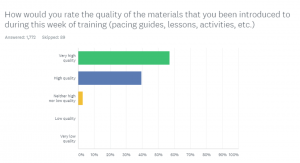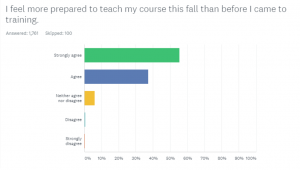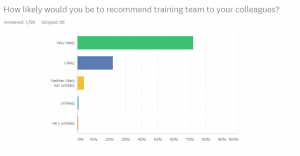This year, our A+ College Ready team adapted our traditionally in-person summer E3 Teacher Training into a virtual format amid COVID-19. The switch was no easy task, and our team previously did not have much experience with creating and facilitating virtual training. However, we enlisted the help of the best technological resources, experts in the field, and our own experienced staff to create high-quality, content-specific virtual trainings for educators. Throughout the process, our team adapted to the need and learned so much. Tammy Dunn, A+ College Ready’s VP of Academic Affairs, shares our top 5 lessons learned and feedback from teachers who participated in the virtual training:
Setting the Scene
It is March, 2020. The A+ College Ready team has been working since fall of 2019 preparing for their annual E3 summer training event that consists of four days of face-to-face training in 26 different courses in math, science, English, social studies, and computer science along with AP summer training in 12 different courses. The original summer plans included eight sessions of E3 training in locations throughout Alabama and two separate Advanced Placement Summer Institutes.
A+ College Ready team members are already working remotely from their homes because of the Covid-19 pandemic. It is rumored that Alabama students will not return to school buildings following spring break week. Large gatherings of people are either cancelled or moved to a virtual format.
The A+ College Ready team faced a conundrum. Should we move forward with a plan for face-to-face training and hope the Covid-19 threat was short lived, or should we move our training to an online/virtual format? The decision was difficult given that A+ College Ready had little experience with virtual training.
Trying to forecast the summer was almost impossible, and we needed to get to work immediately so we could be prepared for our teachers. That’s why we made the decision to transition our face-to-face training to a virtual format. Don’t get me wrong. It was a BITTER decision. A+ College Ready has twelve years of experience of delivering high-quality, research-based, in-person professional learning. Attempting to transition 152 days of in-person training across 38 courses to a virtual format, with no experience in developing virtual learning, was a daunting task.
5 Lessons Learned From the Shift From In-Person to Virtual Training
We knew we’d need the right tools and resources to ensure the highest quality possible. We purchased 60 Zoom licenses and renewed our Canvas subscription. We hired a video editor, created a YouTube channel, and began making videos of lessons, labs, strategies, and explanations. We hired consultants who, under our content directors’ guidance, developed engaging virtual lessons and assignments to simultaneously teach content, pedagogy, and build a trusting learning community. Our administrative team developed a whole new set of logistics for registration, attendance and communications to participants for the virtual experience and trained to provide technical support for our participants. It was quite the undertaking. As I reflect on this journey, here are my five major takeaways:
1. The A+ College Ready team learned more during the last six months than in the last ten years.
I take pride in being a life-long learner. I challenge members of our team to constantly grow as educational professionals and to stay abreast of research in each of their areas. However, when we were challenged to immediately go from our comfort zone of in-person training to our unknown zone of virtual training, the growth curve was steep. Every member of our team was forced to step away from our areas of confidence to our areas of discomfort. We began learning with the expertise on our team. Thank goodness for Dr. Matt Dean, our AP Science content director, who was able to train us all in the use of our Learning Management System, Canvas. Not only did he provide our team training but he also supported both our team members and our participants throughout the summer of training. When we didn’t have expertise on our team, we found other experts to support our work. The AMSTI team at the ALSDE allowed us to join their Zoom webinars where we better learned to create breakout rooms and engage participants with various Zoom tools. We hired other educators that were successful in using virtual tools to share their ideas with our team. In hindsight, our team will tell you that this journey was very stressful, but that we learned more than we ever imagined.
2. If you build it WELL, they will come.
A+ College Ready had already opened registration for all eight sessions of summer training prior to the decision to move to a virtual training format. One of our early fears was that participants who had registered for the in-person training would cancel their registration when they heard it would be virtual versus face-to-face. Gladly, we were wrong. While a few people did cancel their registrations, there was an immediate uptick in the number of people signing up for training. After the first session in June, the word began to spread that the training was excellent and the numbers continued to rise. A+ College Ready had two separate agreements with the ALSDE to train math teachers for the new Alabama Course of Study for Mathematics and to train middle and high school computer science teachers. In these two areas, we had to raise the attendance caps on classes. In almost every session, these courses were at capacity with Alabama teachers. I am so grateful to our leaders in math, Lee Ann Latta and Kitty Morgan, and computer science, Gina McCarley and Carol Yarbrough, who shouldered the burden of participants in that first session. Their excellent work, along with the engaging course facilitators they appointed, led to a spread of interest in the training opportunities. By the end of summer, over 2,400 Alabama teachers attended one of the A+ College Ready training sessions.
3. Teachers came to training for subject matter training, but they also came to experience virtual learning and to get some ideas for leading virtual learning in their schools.
The A+ College Ready’s goals for summer training were the same as they have been for each summer of the past twelve years:
- Provide teachers with high-quality, engaging curricular materials to raise academic rigor in their classrooms.
- Train teachers to use the curricular materials with high-leverage pedagogical strategies that have been proven to raise student achievement.
As we transitioned to virtual learning, these were still our objectives. In the beginning, we did not realize that teachers would come to training to not only learn content and pedagogy, but they chose to come to training to learn to teach their subject in a virtual format! Of the almost 1800 teachers who completed our exit survey, 56% of them had never participated in any kind of virtual learning. Yet, these teachers realized that they were most likely going to have to return to school in the fall and deliver some of their instruction on an online platform. When asked what was the best thing about this doing training course virtually compared to in-person training, some of the participants said:
“I needed this experience to help me begin to feel confident in presenting to my own students virtually as I expect to have to do this year.”
“We were able to sit in the student seat virtually. That gave me ideas on how to implement certain things in the new school year.”
4. Virtual training can yield positive results!
I must admit we were hesitant about achieving our goals for summer training. A+ College Ready has a long, solid history of providing in-person teacher training that has been highly acclaimed by participants. Past evaluation results, exit interviews, and administrator reports all confirm that teachers’ subject-specific and pedagogical content knowledge were significantly improved as a result of A+ College Ready training and that the curricular materials were superior. Could virtual teacher training produce the same results? The survey results are in for almost 1,900 teachers who attended training this summer. This is what they had to say:




In addition to the responses above, only 54% of the participants reported that they were either extremely or very interested in attending summer training. When asked how happy they were that they actually attended the virtual training, 90% reported that they were extremely or quite happy that they attended the training! In their own words:
“Thank you for giving such great examples of virtual learning. I had no clue where to begin for next year and was quite anxious about how virtual or social distanced effective learning might look. This has given me some ideas of how to keep my students learning and safe.”
“I am so very thankful for ALL you all do to help teachers be our best for our students and gain new tools, activities and techniques to share with our colleagues.”
“It was a great training, especially for a first-year teacher like myself!”
“It is clear to see that the training was well-planned and thoughtfully developed. I’d like to offer my sincere gratitude for all of the people who worked countless hours developing the curricula and training plans. I am seriously in your debt!”
“This was the first grade and content specific training I have had in 12 years teaching. If you gave this time and more were involved, this could become a means to perhaps keeping teachers in the field. My colleagues and facilitators sharpened me very much.”
“Keep up the awesome work you guys are doing in helping us teach our students. You guys make adjustments and keep right on rolling. Holding us and our students to a high expectation.”
“Really informative course for someone who has never taught computer science. I am looking forward to putting into practice what I have learned and learning from my students as well.”
“I was excited to be a part of this PD, but I was very anxious and concerned with it being virtual. However, our instructors did an outstanding job. Even though we were physically apart, we were never on our own. Overall, I’m very happy I was able to be a part of this PD and I’m very excited to use this program in the future.”
“This was, by far, the best training I have attended in my 20 years of teaching! I was able to visualize using every strategy in the classroom and how valuable it will be! As we moved through the strategies, I felt some strategies would have helped me if they were delivered first.”
5. A+ College Ready is forever changed
I admit that A+ College Ready has been slow to embrace the virtual teaching format. But 2020 and the COVID-19 pandemic forced us to adapt. I certainly hope that soon we can resume our face-to-face training events with Alabama teachers. However, I know for certain that virtual training will, from this point forward, always be a selection on our menu of professional learning. Although the summer training season has passed, we are now moving on to our fall training events, taking what we have learned from our summer experience, and adding more virtual tools, techniques, and strategies as we go. I know that many things are going to be different in the future because of our experiences of the last six months.

0 Comments on "Lessons Learned: Virtual Professional Learning and Teacher Training in the Time of COVID-19"